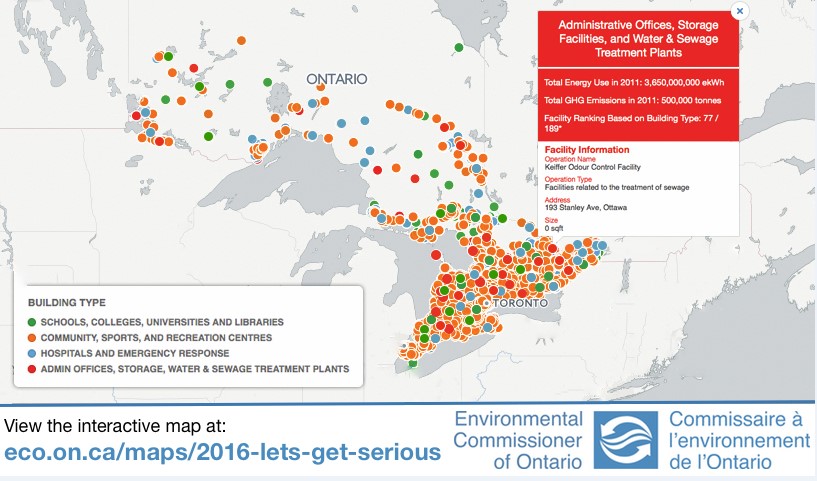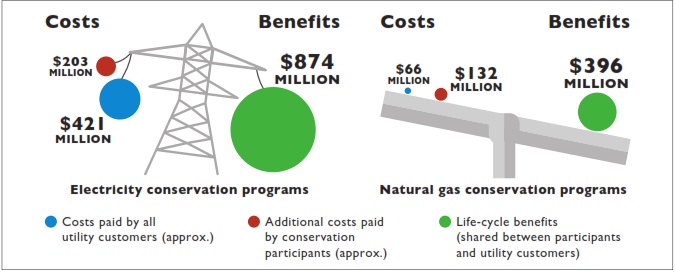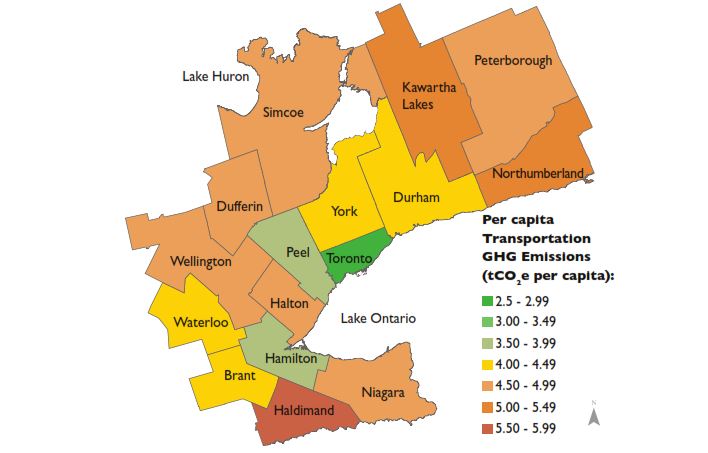This blog post was prepared by Dianne Saxe, the Environmental Commissioner of Ontario, an independent officer of the Legislature. The Environmental Commissioner is the guardian of the Environmental Bill of Rights, and reports on government progress on energy, environment and climate.
I published my first report as your Environmental Commissioner, called “Conservation: Let’s Get Serious,” on May 31, 2016. It focused on a few different areas, including the value of energy conservation, energy consumption in many of the province’s buildings, and a look at our use of transportation fuel. What did we find?
Energy conservation and efficiency continue to be the cheapest and cleanest source of new energy. Electricity ratepayers paid $421 million in 2014 for utility conservation programs that produced predicted lifetime energy savings of 14.6 billion kWh, for a net cost to ratepayers of 2.9 cents per kWh saved. Compared to other forms of electricity, this is a bargain. However, Ontario’s focus on electricity, which is the smallest and cleanest of our major sources of energy, is unbalanced. Ontario is spending more than four times as much on electricity conservation as on natural gas conservation between 2015 and 2020, although natural gas provides nearly twice as much of Ontario’s energy.
Not surprisingly, electricity use has gone down while fossil fuel use has gone up. For more details, check out our office’s useful summaries of electricity conservation programs and natural gas conservation programs.
So what would it take to get serious about conserving fossil fuels?
We recommend that all public bodies in Ontario get serious about a cleaner, leaner, greener approach to fossil fuels. Until recently, lack of transparency has made it impossible to hold public bodies accountable for their energy use. Ontario residents can now see three years’ worth of energy data for roughly 15,000 individual buildings in the broader public sector (e.g., municipalities, hospitals, universities, colleges, and schools). The Ministry of Energy has collected this data since 2012 under O. Reg. 397/11 of the Green Energy Act, 2009. The data was eventually released in a spreadsheet, which we analyzed and converted into an interactive map.
 From the numbers, we see a huge opportunity to save money and emissions by learning from better buildings. If all broader public sector buildings performed as efficiently as the top quarter of their building type, taxpayers could save $450 million and 1 megatonne of greenhouse gas emissions every year. The map contains profile information on each building: name, address, weather-normalized energy use, greenhouse gas emissions, energy intensity and its rank among peers. We have identified the opportunities by making the data available in this user-friendly format. And I think there is great potential for the engineering profession, conservation practitioners and building owners to follow through and implement innovative solutions.
From the numbers, we see a huge opportunity to save money and emissions by learning from better buildings. If all broader public sector buildings performed as efficiently as the top quarter of their building type, taxpayers could save $450 million and 1 megatonne of greenhouse gas emissions every year. The map contains profile information on each building: name, address, weather-normalized energy use, greenhouse gas emissions, energy intensity and its rank among peers. We have identified the opportunities by making the data available in this user-friendly format. And I think there is great potential for the engineering profession, conservation practitioners and building owners to follow through and implement innovative solutions.
We also recommend that Ontario rethink policies favouring car-dependent suburbs. Transportation demand is large, and it represents Ontario’s biggest source of greenhouse gas emissions. Transportation demand is driven primarily by how we plan our communities, especially by urban sprawl, which is why examining land use is particularly important.
From looking at the Greater Golden Horseshoe, we see that per capita greenhouse gas emissions are higher where urban densities are lower, and emissions are lower in the more dense inner areas.
Ontario needs land use planning, infrastructure and taxation law, and policy to favour compact complete communities, with enough density to make walking, biking, and transit good-quality options for daily transportation.
Ontario is also well placed to electrify transportation because of our ample, widely available, low-carbon electricity supply, provided that most vehicle charging occurs in off-peak hours at night. Enhanced time of use rates and load control technology, as recommended by OSPE, can help ensure that electric vehicle charging occurs at the right times.
As I said in the report, Ontario already knows how and why to conserve more energy. It’s time to get serious and do it!
If you have any questions or comments about the report, please contact the Environmental Commissioner of Ontario’s office directly at conservation.report@eco.on.ca or 1-800-701-6454.
OSPE will be providing input and recommendations to the Environmental Commissioner of Ontario regarding her first report. We will also be incorporating comments received from members. Feel free to contact the Commissioner directly, or provide your comments below. Stay tuned for a follow up blog post containing OSPE’s recommendations to the ECO.







Leave a Comment